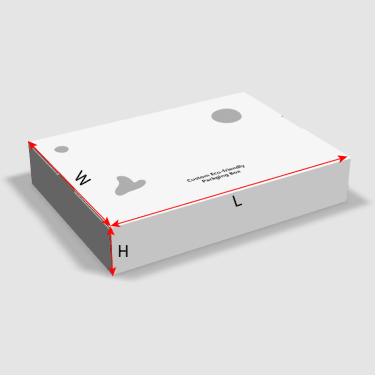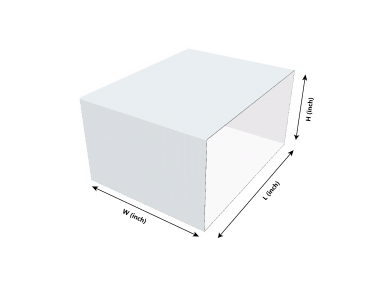Box Dimensions
The dimensions of a box play a vital role in its packaging. A box's length, width, and height must be carefully determined to ensure that the product fits securely inside, with enough space to avoid damage during transportation. The size of the box also affects the cost of shipping and the amount of materials required for its construction. As such, it is essential to consider the dimensions of the box carefully and make any necessary adjustments to ensure that the packaging is effective and cost-efficient.
Boxes are commonly measured by their length, width, and height. However, some individuals may refer to the size of a package as its depth. Additionally, the order in which these dimensions are listed may vary based on personal preference. This lack of measurement standardization can confuse vendors and customers when ordering customized packaging.
To help you better understand a box’s dimensions, measure it accurately, and avoid any misunderstanding, we ‘ve created the box dimension guidelines for easy reference and communication.

 It would be best if you remembered that when you configure custom packaging, measure and apply the inner dimensions, while when you calculate the delivery charges or warehousing space, measure and apply the outer dimensions.
It would be best if you remembered that when you configure custom packaging, measure and apply the inner dimensions, while when you calculate the delivery charges or warehousing space, measure and apply the outer dimensions.
When measuring the dimensions of a box, it is standard to use















Standard measuring units such as inches, centimeters, and millimeters are typically used when measuring a box. It is essential to select the correct division when configuring a custom box. At CEF Box, both inches and centimeters are available for specifying a box's dimensions. However, when generating a die-line drawing, the options available are inches and millimeters.
It's essential to consider the volume of a box when packing your product. It helps you understand how well your product will fit inside and gives you a better idea of your warehousing, shipping, and distribution process. There are two terms to consider when determining the volume: gloss volume and net volume.
Gloss volume refers to the space the box will occupy, while the net volume is the area you can use to load a product. Gloss volume is used to calculate delivery charges and warehousing space.
To calculate the volume of a cubic box, you can use the formula: Length x Width x Height (Depth). You can multiply them to get the result or use an online calculator.
It's worth noting that you should apply the outside dimensions to the formula if calculating the shipping cost. On the other hand, when calculating the actual loading space, you should apply the inside dimensions.
Boxes are commonly measured by their length, width, and height. However, some individuals may refer to the size of a package as its depth. Additionally, the order in which these dimensions are listed may vary based on personal preference. This lack of measurement standardization can confuse vendors and customers when ordering customized packaging.
To help you better understand a box’s dimensions, measure it accurately, and avoid any misunderstanding, we ‘ve created the box dimension guidelines for easy reference and communication.
1. Understand the difference between inside dimensions and outside dimensions.
A box's inside dimensions represent the space available for loading products, while its outside dimensions represent the space occupied during storage or transportation. There may be a big gap between them, considering the different construction and materials of boxes, especially when configuring the corrugated boxes.
A box's inner dimensions

A box's outer dimensions
There can be a big gap between inner and outer dimensions of a box due to construction and materials
2. Understand the order of box dimensions
When measuring the dimensions of a box, it is standard to use
Length x Width x Height (L x W x H)
or
Length x Width x Depth (L x W x D).
or
Length x Width x Depth (L x W x D).
3. Understand Length, Width, and Height (L, W, H)
It's important to note that when measuring the dimensions of a box, the longest side may not always indicate the box's length. This means that either the width or height could be the longest side. The specific style of the box will determine whether the length, width, or height (depth) should be measured as the longest side. To ensure accurate measurements, please refer to the accompanying drawings.
Mailer box's dimensions

Tear-strip box's dimensions

No-flaps box's dimensions

Without-wings box's dimensions

Straight tuck end box's dimensions

Reverse tuck end box's dimensions

Snap lock bottom box's dimensions

Auto lock bottom box's dimensions

Packaging sleeves' dimensions

RSC box's dimensions

Counter-top box's dimensions

Returnable box's dimensions

Folding divider's dimensions

Crossing divider's dimensions

Packaging insert's dimensions
4. Understand the unit
Standard measuring units such as inches, centimeters, and millimeters are typically used when measuring a box. It is essential to select the correct division when configuring a custom box. At CEF Box, both inches and centimeters are available for specifying a box's dimensions. However, when generating a die-line drawing, the options available are inches and millimeters.
5. Calculating the volume of a box
It's essential to consider the volume of a box when packing your product. It helps you understand how well your product will fit inside and gives you a better idea of your warehousing, shipping, and distribution process. There are two terms to consider when determining the volume: gloss volume and net volume.
Gloss volume refers to the space the box will occupy, while the net volume is the area you can use to load a product. Gloss volume is used to calculate delivery charges and warehousing space.
To calculate the volume of a cubic box, you can use the formula: Length x Width x Height (Depth). You can multiply them to get the result or use an online calculator.
It's worth noting that you should apply the outside dimensions to the formula if calculating the shipping cost. On the other hand, when calculating the actual loading space, you should apply the inside dimensions.